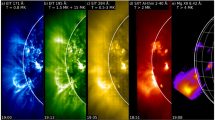Summary
The magnetic field of the Crab Nebula is so large that if the original pre-super nova star had contained it, it must have been on the verge of instability. It is suggested here that this magnetic field did not exist before the explosion which produced the Crab, but was created from the kinetic energy of the expanding matter. To account for the observed magnetic field of ∼ 10−3 G a machinery is proposed which derives from the existence of shock waves in the exploding shell, from the existence of charge separation in the shock fronts, and from the formation of irregularities in the surfaces where charge separations exist, at some time during their propagation from regions of very high density in the star interior out into the very low galactic density. The magnetic field of 10−3 G, now believed to exist in the Crab, follows from the present theory, if one assumes the experimental value of 103/cm3 for the density in the filaments.
Riassunto
II campo magnetico della netmlosa del Granchio è così vasto che se la pre-supernova originale l’avesse contenuto avrebbe dovuto trovarsi al limite dell’instalbilità. Si suggerisce qui che questo campo magnetico non esisteva prima dell’esplosione che produsse il Granchio, ma fu invece creato dall’energia della materia in espansione. Per render conto del campo magnetico creato di ∼ 10−3 G si propone un meccanismo derivante dall’esistenza di onde d’urto nell’esplosione della stella, dall’esistenza di separazione di carica nei fronti d’urto, e dalla formazione di irregolarità sulle superfici dove esistono separazioni di carica in qualche tempo durante la loro propagazione da regioni di altissima densità dell’interno della stella a regioni di bassissima densità galattica. Il campo magnetico di 10−3 G, che presentemente si ritiene esistere nel Granchio, consegue dalla teoria esposta se per la densità dei filamenti si assume il valore sperimentale di 103/cm3.
Similar content being viewed by others
References
J. H. Oort andTh. Waleaven:Bull. Am. N.,12, no. 462, 285 (1956).
S. Chandrasekhak:MNRAS,113, 667 (1953). See also footnote p. 304 in Ooet and Walraven (1).
A. Kantrowitz :Experiments on the radiation and ionization produced by strong shock waves, inGas Dynamics of Cosmic Clouds, A Symposium (New York, 1955).
H. Petschek andS. Byron:Ann. of Phys.,1, 270 (1957).
SeeH. Lamb:Hydrodynamics, 6th ed. (1932), p. 374;G. I. Taylor:Proc. Roy. Soc,201, 192 (1950); andD. J. Lewis:Proc. Roy. Soc.,202, 81 (1950).
D. E. Osterbrock:Astron. Journ. Pacif.,69, no. 408, 227 (1957).
Author information
Authors and Affiliations
Additional information
Research supported by a joint program of the Office of Naval Eesearch and the U. S. Atomic Energy Commission.
Presently on leave of absence to Brookhaven National Laboratory, Upton, New York.
Rights and permissions
About this article
Cite this article
Marshall, L. Production of the magnetic field of the Crab Nebula. Nuovo Cim 12, 477–482 (1959). https://doi.org/10.1007/BF02745789
Received:
Published:
Issue Date:
DOI: https://doi.org/10.1007/BF02745789




